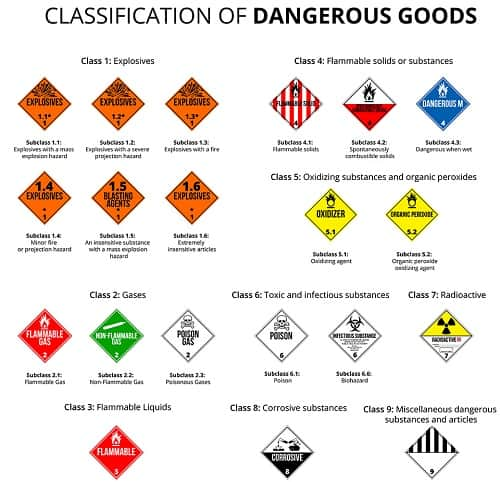DOT Hazard Classes
How Many DOT Hazard Classes Are There?
The U.S. Department of Transportation (DOT) hazardous materials regulations governs the transportation of hazardous materials in commerce within the jurisdiction of the United States, for shipments to, from, and through the United States. Hazardous Materials are defined as substances or materials that the Secretary of Transportation has determined to be capable of posing an unreasonable risk to health, safety, and property when transported in commerce. Examples of hazardous materials include laboratory reagents, pool chemicals, lubricating oils, paint, batteries, infectious substances, dry ice, and hazardous wastes. Hazardous materials shippers are required to identify, classify, package, mark, label, document, and/or tender hazardous materials into transportation.
More specifically, the Pipeline and Hazardous Materials Safety Administration (PHMSA) is responsible for regulating the safe and secure movement of hazardous materials to industry and consumers by all modes of transportation, including pipelines. Labels and placards are required to identify these hazardous materials, especially to aid first responders in identifying associated material hazards in the minutes following an incident. To minimize threats to life, property, or the environment due to these hazardous materials-related incidents, PHMSA's Office of Hazardous Materials Safety develops regulations and standards for the classifying, handling, and packaging of over 1 million daily shipments of hazardous materials within the United States. Applicable regulations can be found at PHMSA, with specific reference to 49 CFR part 172 eCFR :: 49 CFR Part 172 -- Hazardous Materials Table, Special Provisions, Hazardous Materials Communications, Emergency Response Information, Training Requirements, and Security Plans. There are thousands of specific types of hazardous materials contained within PHMSA's Emergency Response Guidebook (ERG). The ERG is intended for use by first responders during the initial phase of a transport incident involving hazardous materials.
Hazard Classes.
DOT regulations have grouped hazardous materials into nine specific hazard classes. They include:

- Explosives. Includes Divisions 1.1, 1.2, 1.3, 1.4, 1.5 and 1.6 eCFR :: 49 CFR 173.50 -- Class 1 - Definitions.
- Gases. Includes Divisions 2.1, 2.2 and 2.3, which further include oxygen, flammable and non-flammable gas, and inhalation hazard eCFR :: 49 CFR 173.115 -- Class 2, Divisions 2.1, 2.2, and 2.3 - Definitions.
- Flammable Liquid and Combustible Liquid. Includes gasoline and other fuel oils. eCFR :: 49 CFR 173.120 -- Class 3 - Definitions.
- Flammable Solid, Spontaneously Combustible, and Dangerous When Wet. Includes Divisions 4.1, 4.2 and 4.3 eCFR :: 49 CFR 173.124 -- Class 4, Divisions 4.1, 4.2 and 4.3 - Definitions.
- Oxidizer and Organic Peroxide. Includes Divisions 5.1 and 5.2 eCFR :: 49 CFR 173.128 -- Class 5, Division 5.2 - Definitions and types.
- Poison (Toxic) and Poison Inhalation Hazard. Includes Divisions 6.1 and 6.2 eCFR :: 49 CFR 173.132 -- Class 6, Division 6.1 - Definitions.
- Radioactive. eCFR :: 49 CFR 173.403 -- Class 7 - Definitions.
- Corrosive. eCFR :: 49 CFR 173.136 -- Class 8 - Definitions.
- Miscellaneous, General Dangerous. Not meeting the definition of any other hazard class. eCFR :: 49 CFR 173.140 -- Class 9 - Definitions.
A Federal Motor Carrier Safety Administration (FMCSA) quick reference yellow visor card for these hazardous materials classes can be reviewed on the FMCSA website.
Employee Training.
It's also a good time to revisit associated DOT HAZMAT employee training requirements eCFR :: 49 CFR Part 172 Subpart H -- Training. This training applies to any employee who:
- Loads, unloads, or handles hazardous materials or hazardous waste.
- Manufactures, tests, reconditions, repairs, modifies, marks, or otherwise represents containers, drums, or packages as qualified for use in the transportation of hazardous materials or hazardous waste.
- Prepares any hazardous materials or hazardous waste for transportation.
- Is responsible for the safety of transporting hazardous materials or hazardous waste.
- Operates a vehicle used in the transportation of hazardous materials or hazardous waste.
Section 172.704 states that HAZMAT training shall include initial and recurring (every three years) training that provides familiarity with the general requirements of the Hazardous Materials regulations and enables the employee to recognize and identify hazardous materials. This training will provide a basic understanding of:
- Identification of hazardous materials
- Hazard classification system
- Hazardous materials table
- Packaging
- Markings and labels
- Placards
- Shipping papers
- Segregation
- Understanding of hazardous materials regulations training requirements
- Requirements for incident reporting
- Security.
Learn more about DOT Hazardous Materials Transpotation by taking the online training from National Environmental Trainers.

